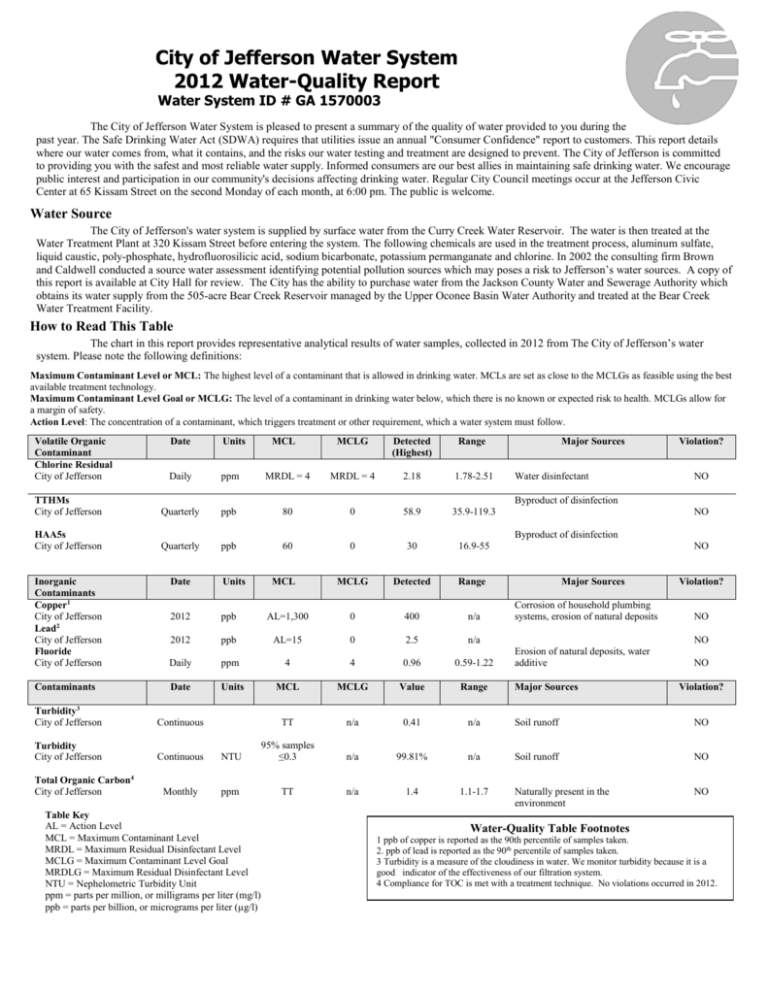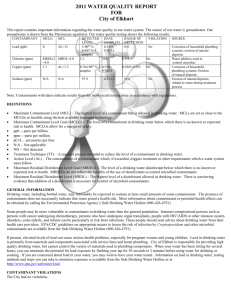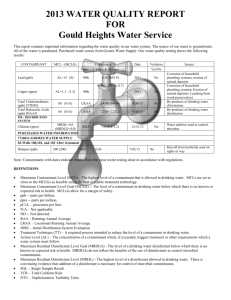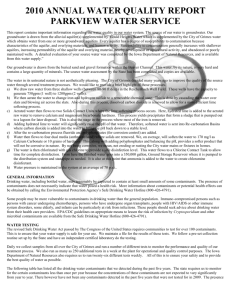Clayton Water System
advertisement

City of Jefferson Water System 2012 Water-Quality Report Water System ID # GA 1570003 The City of Jefferson Water System is pleased to present a summary of the quality of water provided to you during the past year. The Safe Drinking Water Act (SDWA) requires that utilities issue an annual "Consumer Confidence" report to customers. This report details where our water comes from, what it contains, and the risks our water testing and treatment are designed to prevent. The City of Jefferson is committed to providing you with the safest and most reliable water supply. Informed consumers are our best allies in maintaining safe drinking water. We encourage public interest and participation in our community's decisions affecting drinking water. Regular City Council meetings occur at the Jefferson Civic Center at 65 Kissam Street on the second Monday of each month, at 6:00 pm. The public is welcome. Water Source The City of Jefferson's water system is supplied by surface water from the Curry Creek Water Reservoir. The water is then treated at the Water Treatment Plant at 320 Kissam Street before entering the system. The following chemicals are used in the treatment process, aluminum sulfate, liquid caustic, poly-phosphate, hydrofluorosilicic acid, sodium bicarbonate, potassium permanganate and chlorine. In 2002 the consulting firm Brown and Caldwell conducted a source water assessment identifying potential pollution sources which may poses a risk to Jefferson’s water sources. A copy of this report is available at City Hall for review. The City has the ability to purchase water from the Jackson County Water and Sewerage Authority which obtains its water supply from the 505-acre Bear Creek Reservoir managed by the Upper Oconee Basin Water Authority and treated at the Bear Creek Water Treatment Facility. How to Read This Table The chart in this report provides representative analytical results of water samples, collected in 2012 from The City of Jefferson’s water system. Please note the following definitions: Maximum Contaminant Level or MCL: The highest level of a contaminant that is allowed in drinking water. MCLs are set as close to the MCLGs as feasible using the best available treatment technology. Maximum Contaminant Level Goal or MCLG: The level of a contaminant in drinking water below, which there is no known or expected risk to health. MCLGs allow for a margin of safety. Action Level: The concentration of a contaminant, which triggers treatment or other requirement, which a water system must follow. Volatile Organic Contaminant Chlorine Residual City of Jefferson Date Units Daily ppm TTHMs City of Jefferson Quarterly HAA5s City of Jefferson Quarterly MCL MCLG Detected (Highest) Range MRDL = 4 MRDL = 4 2.18 1.78-2.51 ppb 80 0 58.9 35.9-119.3 ppb 60 0 30 16.9-55 MCLG Detected Range Major Sources Water disinfectant Violation? NO Byproduct of disinfection NO Byproduct of disinfection Date Units MCL 2012 ppb AL=1,300 0 400 n/a 2012 ppb AL=15 0 2.5 n/a NO Inorganic Contaminants Copper1 City of Jefferson Lead2 City of Jefferson Fluoride City of Jefferson Daily ppm 4 4 0.96 0.59-1.22 Contaminants Date Units MCL MCLG Value Range TT n/a 0.41 n/a Soil runoff NO Soil runoff NO Naturally present in the environment NO Turbidity3 City of Jefferson Continuous Turbidity City of Jefferson Continuous NTU 95% samples ≤0.3 n/a 99.81% n/a Monthly ppm TT n/a 1.4 1.1-1.7 Total Organic Carbon4 City of Jefferson Table Key AL = Action Level MCL = Maximum Contaminant Level MRDL = Maximum Residual Disinfectant Level MCLG = Maximum Contaminant Level Goal MRDLG = Maximum Residual Disinfectant Level NTU = Nephelometric Turbidity Unit ppm = parts per million, or milligrams per liter (mg/l) ppb = parts per billion, or micrograms per liter (µg/l) Major Sources Corrosion of household plumbing systems, erosion of natural deposits Violation? NO NO Erosion of natural deposits, water additive Major Sources NO Violation? Water-Quality Table Footnotes 1 ppb of copper is reported as the 90th percentile of samples taken. 2. ppb of lead is reported as the 90th percentile of samples taken. 3 Turbidity is a measure of the cloudiness in water. We monitor turbidity because it is a good indicator of the effectiveness of our filtration system. 4 Compliance for TOC is met with a treatment technique. No violations occurred in 2012. Required Additional Health Information To ensure that tap water is safe to drink, EPA prescribes limits on the amount of certain contaminants in water provided by public water systems. FDA regulations establish limits for contaminants in bottled water. Drinking water, including bottled water, may reasonably be expected to contain at least small amounts of some contaminants. The presence of contaminants does not necessarily indicate that water poses a health risk. More information about contaminants and potential health effects can be obtained by calling the Environmental Protection Agency's Safe Drinking Water Hotline (800-426-4791). The sources of drinking water (both tap water and bottled water) include rivers, lakes, streams, ponds, reservoirs, springs, and wells. As water travels over the surface of the land or through the ground, it dissolves naturally-occurring minerals and radioactive material, and can pick up substances resulting from the presence of animals or from human activity. Contaminants that may be present in source water include: (A) Microbial contaminants, such as viruses and bacteria, which may come from sewage treatment plants, septic systems, agricultural livestock operations, and wildlife. (B) Inorganic contaminants, such as salts and metals, which can be naturally-occurring or result from urban storm runoff, industrial or domestic wastewater discharges, oil and gas production, mining, or farming. (C) Pesticides and herbicides, which may come from a variety of sources such as agriculture, stormwater runoff, and residential uses. (D) Organic chemical contaminants, including synthetic and volatile organics, which are by-products of industrial processes and petroleum production, and can also come from gas stations, urban stormwater runoff and septic systems. (E) Radioactive contaminants, which can be naturally-occurring or be the result of oil and gas production and mining activities. In order to ensure that tap water is safe to drink, EPA prescribes regulations which limit the amount of certain contaminants in water provided by public water systems. FDA regulations establish limits for contaminants in bottled water which must provide the same protection for public health. Some people may be more vulnerable to contaminants in drinking water than is the general population. Immuno-compromised persons such as persons with cancer undergoing chemotherapy, persons who have undergone organ transplants, people with HIV/AIDS or other immune system disorders, some elderly, and infants can be particularly at risk from infections. These people should seek advice about drinking water from their health care providers. EPA/CDC guidelines on appropriate means to lessen the risk of infection by Cryptosporidium are available from the Safe Drinking Water Hotline (800-426-4791). Lead in Drinking Water If present, elevated levels of lead can cause serious health problems, especially for pregnant women and young children. Lead in drinking water is primarily from materials and components associated with service lines and home plumbing. The City of Jefferson Water System is responsible for providing high quality drinking water, but cannon control the variety of materials used in plumbing components. When your water has been sitting for several hours, you can minimize the potential for lead exposure by flushing your tap for 30 seconds to 2 minutes before using water for drinking or cooking. If you are concerned about lead in your water, you may whish to have your water tested. Information on lead in drinking water, testing methods, and steps you can take to minimize exposure is available from the Safe Drinking Water Hotline or at http://www.epa.gov/safewater/lead. National Primary Drinking Water Regulation Compliance If you have any questions please call The City of Jefferson at 706-367-5644 or email at crowel@windstream.net. Water Quality Data for community water systems throughout the United States is available at www.waterdata.com. Individual copies of this report will not be mailed. Copies of this report are available at Jefferson City Hall. This report contains water quality information from the Jefferson water treatment plant (WSID 1570003). Member: Georgia Rural Water Association (GRWA) www.grwa.org Este informe contiene information muy importante. Traduscalo o hable con un amigo quien lo entienda bien.








